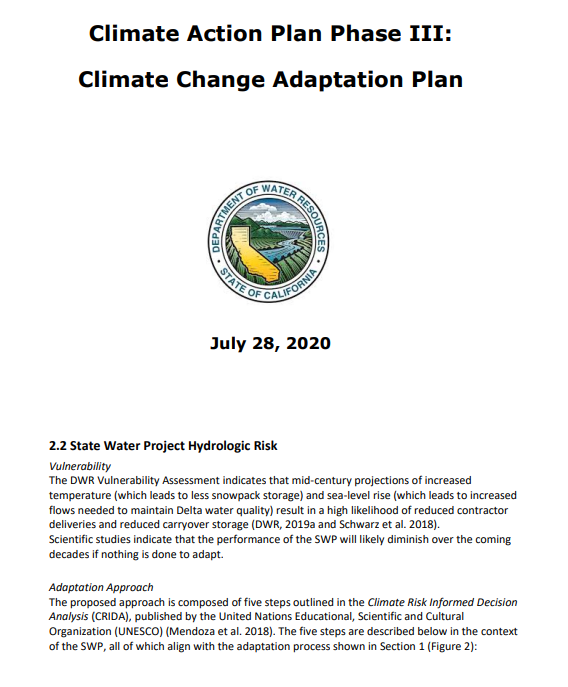State of California Adopts Climate Risk-Informed Decision Analysis (CRIDA) as its Climate Change Adaptation Approach for their State Water Project
California’s $3.2 trillion economy—ranked 5th globally if it were a country—depends greatly on water. Water for agriculture, water for drinking, water for power, and water for ecosystems. California’s Water Plan has a broad and diverse portfolio of recommended actions to address its many often conflicting water challenges—flood risk, surface- and groundwater supplies, and habitat and species resiliency. And this delicate water balance is potentially threatened by climate change.
In July 2020, the California (USA) Department of Water Resources published a formal Climate Change Adaptation Plan. Their mid-century projections show increased temperature (affecting snowpack storage) and sea-level rise (affecting San Francisco Bay-Delta water quality), resulting in reduced water deliveries and storage and an overall decrease in performance of the State Water Project if nothing is done to adapt.

Rather than create a detailed adaptation framework for its State Water Project from scratch, California decided to adopt the Climate Risk Informed Decision Analysis (CRIDA) approach, co-published by ICIWaRM and UNESCO G-WADI and created in collaboration with the Alliance for Global Water Adaptation and Deltares. The five steps of CRIDA align well with California’s own adaptation processes. CRIDA’s steps 1 and 2 (Structuring a Process for Vulnerability Assessment, and Implementing a Bottom-up Vulnerability Assessment) align with their “Understanding” stage. Steps 3 and 4 (Formulating Alternative Plans, and Comparing and Recommending Plans) follow their “Planning” stage. And step 5 (Institutionalizing the Decisions) follows their “Managing” stage.
The “next steps” identified by the State include:
- Coordinate the implementation of the five CRIDA steps for the SWP,
- Examine the adaptation potential of their resource management strategies,
- Incorporate consideration of climate change into SWP’s Asset Management Program, and
- Further explore the vulnerability, adaptive capacity, and adaptation options for the SWP.
